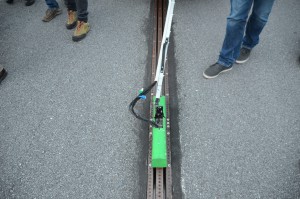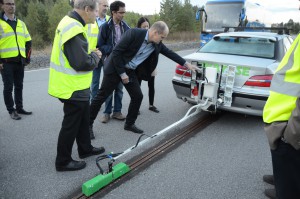DALIAN, Sept. 8 (Xinhua) — Global institutions should better represent the world’s emerging economies, chief among them China, to reflect shifting geo-political realities, said Klaus Schwab, founder and executive chairman of the World Economic Forum, on Tuesday ahead of its annual summer meeting in China.
Robust economic growth from countries like China and India are signs that Asia is once again the economic center of the world, a fact that Schwab said is not being adequately reflected in international governance.
China has long sought greater clout in global institutions commensurate with its growing economic might. The country has led the creation of the Asian Infrastructure Investment Bank, an alternative to the International Monetary Fund and the World Bank, with both developing and developed countries as its perspective founding members.
“I’m very happy that China is taking leadership in developing infrastructure not only in China, but having regional cooperation,” Schwab said.
He said that rather than competing with the IMF and the World Bank, the AIIB will complement existing institutions to fund a trillion dollar infrastructure investment gap, much of it in Asia.
China’s outreach also comes at a time when growth in the world’s second largest economy is moderating on soft investment and trade. Economic growth slowed to 7 percent during the first half this year as traditional drivers such as real estate, heavy industries and exports run out of steam.
But Schwab said the slowdown is “a necessity to transform the economy from production and export-oriented to a more consumer-led and innovation-based model.”
“The future growth will come not so much from traditional sources like manufacturing….China has to orientate its economy towards innovation and creativity,” Schwab said.
China’s vast manufacturing sector has been saddled with overcapacity as domestic and global demand for its industrial goods have weakened amid economic slowdown.
Authorities have since this year announced plans to nurture tech-intensive industries to help China regain its competitive edge in manufacturing. Meanwhile, China’ s budding internet sector has churned out a legion of innovative firms from Alibaba and Tencent to taxi-hailing startup Didi Kuaidi that helps the economy adapt to its new consumers.
These companies, and western equivalents such as Uber and Airbnb, have come up with what Schwab called “a new approach to old business models,” and brought innovation “not just to one product, but the whole system.”
Competitiveness of the Chinese economy in this new era of disruptive technologies, he said, will come from the agility and speed at which businesses adopt new technologies.
“I’ve seen China confronted many times with what seem insurmountable problems,” Schwab said, “What I’m always impressed with is the vision behind China’s economic policies, which allows the country to meet those challenges.” Enditem
Spotlight: China economy enters “new normal” eyeing 7 pct growth rate: G20
ANKARA, Sept. 5 (Xinhua ) — The Chinese economy has entered a “new normal” status and the growth rate of economy is predicted to be around 7 percent in the coming 4 to 5 years, said Chinese Finance Minister Lou Jiwei here on Saturday.
Lou said it in a written statement after the 2-day G20 Finance Ministers and Central Bank Governors Meeting in Ankara Turkey.
Zhou Xiaochuan, People’s Bank of China governor pointed out in the joint statement that there is no foundation that RMB will keep devaluing for a long term.
Zhou Xiaochuan stated that the bubble in Chinese stock market keep increasing before June 2015. The Shanghai Composite Index has mounted up 70 percent from March to June.
Risks as Investors leverage rapid rise occur during this period of time. China has implemented the correction phase of stock market for three times among which the third time in August has some global impacts.
China has been taking measures to prevent its economy from systematic risk including the PBOC providing liquidity to the market through multiple channels.
The measures taken by Chinese government has prevented the stock market from decline in precipice way and the occurrence of systematic risk.
According to the statement, since the August correction in stock market, the Investors leverage in Stock market has been going down significantly and the real economy has not been impacted.
The reform of the middle price quotation of RMB exchange rate mechanism on August 11 is an important step to the marketing reform of RMB rate.
RMB was devalued for a certain degree after the reform, but the RMB was over valued for reasons like the value-up of U.S. dollar ,the generally value depreciate of Currency in emerging market economies.
“But there is no substantial transformation in the real economy of China and large surplus still remains in the foreign trade of China, so there is no foundation that RMB will keep devaluing for a long term,” Governor Zhou strengthened in the Statement.
“The status of Chinese economy is till in predication. The Chinese Economy has entered a “new normal” status and the growth rate of economy is predicted to be around 7 percent in the coming 4 to 5 years” Chinese Finance Minister of Lou Jiewei said in the joint statement.
It is stated that there are mainly two reasons that the growth rate of China will enter the 7 percent period.
Firstly, the rapid growth rate which keeps 9-10 percent in the past and highly depends on the stimulation of policy is not sustainable, and is over the potential growth rate of China which lead to over capacity and mass increase of inventory. It will take years to consume these over capacity and inventory.
The next 5 years will be a painful period for the reform of Chinese economy, and the main goals need to be achieved by 2020. China’s economy will be mainly driven by consumption rather than investment and foreign trade during the reforming period, and this will not be an easy job to accomplish.
Secondly, China’s economic cycle is different with the developed countries. Developed countries generally initiated the process of deleveraging after the global crisis, however, China initiated its leveraging process between 2009 and 2010 and achieved the 10 percent in growth rate.
The contribution rate to growth of global economy was as high as 50 percent above during that time. China now is initiating its process of deleveraging and the growth rate will down to 7 percent but still making 30 percent contribution rate to growth of global economy.
Lou stressed in the statement that there are some positive changes in Chinese economy despite the lower of growth rate, including the contribution rate to growth of consumption comes higher than that of investment, the proportion of service in GDP over passed industry, the proportion of trade surplus in GDP has been decreasing, 7 million new jobs was created in the first half year, the quality of economic growth keeps rising etc.
China will continue to implement a proactive fiscal policy and the increasing rate of central government spending is predicted to be 10 percent, which is higher than the 7 percent budget.
China is taking measures to plug fiscal gap to maintain moderate economic growth and support the structural reform, the statement added.
“The Chinese government will not pay particular attention to a seasonal short term economic fluctuation, and will keep the stability of macroeconomic policies,” Lou pointed out in the statement.
China has achieved a 7 percent growth despite the decreasing of demographic dividend and falling on rate of capital return.
The huge potential of Chinese economy lies in reform and China is unswervingly promote reform and opening up in accordance with the established plan.
“G20 financial ministers and central bank governors have talked about the economy problems in China and we are not pessimistic about China keeping the 7 percent growth rate in the future,’ Deputy Prime Minister of Turkey Cevdet Yilmaz said in the press conference Saturday in Ankara. Enditem

 Elways负责人介绍说,此前人们有很多设想,最有名的就是在空中建立轨道让后让轿车在6米高的轨道上行走。计算下来,成本太高。而他所发明的公路上的微型双轨主要是用来充电的。
Elways负责人介绍说,此前人们有很多设想,最有名的就是在空中建立轨道让后让轿车在6米高的轨道上行走。计算下来,成本太高。而他所发明的公路上的微型双轨主要是用来充电的。 这位负责人说,对于电动车来说最大的问题是电池的电力不足。充一次电只能跑最多不到100 公里。如果是大卡车,需要的电池更多,更重。很不方便。那么他发明的电动轨道是两个一厘米宽的两个槽,电动车可以通过走这个轨道的过程来充电。这样,跑上一段时间,就可以把电充满了。
这位负责人说,对于电动车来说最大的问题是电池的电力不足。充一次电只能跑最多不到100 公里。如果是大卡车,需要的电池更多,更重。很不方便。那么他发明的电动轨道是两个一厘米宽的两个槽,电动车可以通过走这个轨道的过程来充电。这样,跑上一段时间,就可以把电充满了。 预计,再有两三年,这个试验就会有结果是否上马。目前,这是瑞典有关方面认为实现可持续交通的一个可行性项目,因此,一直在给予资助进行试验。参与的有11家公司,企业,皇家科技学院,瑞典道路交通管理局,阿兰达机场和斯德哥尔摩市。
预计,再有两三年,这个试验就会有结果是否上马。目前,这是瑞典有关方面认为实现可持续交通的一个可行性项目,因此,一直在给予资助进行试验。参与的有11家公司,企业,皇家科技学院,瑞典道路交通管理局,阿兰达机场和斯德哥尔摩市。

